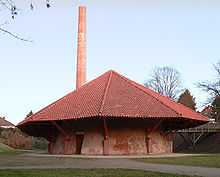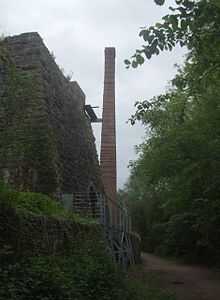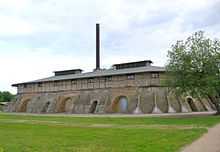Hoffmann kiln


The Hoffmann kiln is a series of batch process kilns. Hoffmann kilns are the most common kiln used in production of bricks and some other ceramic products. Patented by German Friedrich Hoffmann for brickmaking in 1858, it was later used for lime-burning, and was known as the Hoffmann continuous kiln.

Construction and operation
A Hoffmann kiln consists of a main fire passage surrounded on each side by several small rooms. Each room contains a pallet of bricks. In the main fire passage there is a fire wagon, that holds a fire that burns continuously. Each room is fired for a specific time, until the bricks are vitrified properly, and thereafter the fire wagon is rolled to the next room to be fired.
Each room is connected to the next room by a passageway carrying hot gases from the fire. In this way, the hottest gases are directed into the room that is currently being fired. Then the gases pass into the adjacent room that is scheduled to be fired next. There the gases preheat the brick. As the gases pass through the kiln circuit, they gradually cool as they transfer heat to the brick as it is preheated and dried. This is essentially a counter-current heat exchanger, which makes for a very efficient use of heat and fuel. This efficiency is a principal advantage of the Hoffmann kiln, and is one of the reasons for its original development and continued use throughout history.[1] In addition to the inner opening to the fire passage, each room also has an outside door, through which recently fired brick is removed, and replaced with wet brick to be dried and then fired in the next firing cycle.
In a classic Hoffmann kiln, the fire may burn continuously for years, even decades; in Iran, there are kilns that are still active and have been working continuously for 35 years. Any fuel may be used in a Hoffmann kiln, including gasoline, natural gas, heavy petroleum and wood fuel. The dimensions of a typical Hoffmann kiln are completely variable, but in average about 5 m (height) x 15 m (width) x 150 m (length).
Historic examples of Hoffmann kilns
The Hoffmann Kiln is used in almost every country. In the British Isles there are only a few Hoffmann kilns remaining, some of which have been preserved. The only ones with a chimney are at Prestongrange Industrial Heritage Museum and Llanymynech Heritage Area. The site at Llanymynech, close to Oswestry was used for lime-burning and has recently been partially restored as part of an industrial archaeology conservation project supported by English Heritage and the Heritage Lottery Fund.[2] The Hoffmann lime-burning kiln at Meal Bank Quarry, Ingleton is a Scheduled Ancient monument -1020889
There is an intact but abandoned Hoffmann kiln without a chimney present at Minera Limeworks; the site is abandoned but all entrances to the kiln have been grated-off, preventing access. The kiln is in a very poor state of repair, with trees growing out of the walls and the roof. Minera Quarry Trust hopes one day to develop the area into something of a tourist attraction. There is a partly preserved Hoffmann lime kiln that was operated by the Craven Lime Works company at Langcliffe in the Yorkshire Dales.[3][4] The Grade II listed Hoffmann brick kiln in Ilkeston, Derbyshire, is also badly neglected, although the recently installed fencing offers some protection for the building and for visitors.[5] At Prestongrange Museum, outside Prestonpans in East Lothian, the Hoffman kiln is still standing and visitors can listen to more about it via a mobile phone tour. There is also a nearly complete kiln in Horeb, Carmarthenshire.[6] At the Brunswick brickworks in Victoria, Australia, there are two surviving kilns converted to residences, and a chimney from a third kiln, another in Box Hill, also in Melbourne and one in Adelaide, South Australia.[7] Also, two in New Zealand.


References
- ↑ The History Channel, Modern Marvels, "Bricks", repeat: April 18, 2008
- ↑ "Clwyd-Powys Archaeological Trust - Projects - Recent projects - Llanymynech". Cpat.org.uk. Retrieved 2013-08-04.
- ↑ http://www.langcliffe.net/Hoffmans%20Kiln.html[]
- ↑ "A landscape through time". Out of Oblivion. Retrieved 2013-08-04.
- ↑ Good Stuff IT Services. "Brick Kiln - Erewash - Derbyshire - England". British Listed Buildings. Retrieved 2013-08-04.
- ↑ http://www.britishlistedbuildings.co.uk/wa-20537-hoffmann-kiln-of-eclipse-brickworks-llane
- ↑ Iain Stuart, Why Did the Hoffman Brick and Pottery Works Stop Making Bricks? Australian Historical Archaeology 7, 1989
External links
- http://www.llanymynech-hoffman.co.uk/DIR1/History.htm
- http://www.prestongrange.org/tour/3.html
- http://www.itcltd.com/wastedisposal/1.1.4.d.Evaluation%20of%20Hoffman%20Kiln%20Technology.pdf
- http://www.britishlistedbuildings.co.uk/en-352235-brick-kiln-ilkeston
- http://canmore.rcahms.gov.uk/en/site/151546/details/armadale+etna+brickworks/ RCAHMS Canmore
- http://au.news.yahoo.com/thewest/a/-/wa/18074142/laying-a-case-for-brickworks/
| Wikimedia Commons has media related to Ring kilns. |